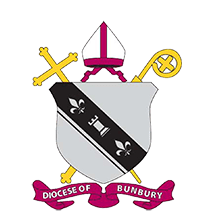Bunbury
The site of the future Cathedral Town of Bunbury was declared in 1829, the very year the State was founded, but it was not until 1841 that the town site was surveyed. Lieutenant Henry William Bunbury, after whom it was named, was an officer of the 21 Regiment of Fusiliers and an early explorer in the south west area of WA and it was he who successfully urged settlement and farming in the area in 1836. A military station had been founded close to Bunbury on 6 March 1830 at Port Leschenault (named after the botanist on the French ship, Geographe, which called there in 1802).
The post closed when the garrison was recalled to Perth before the end of the year. The district’s progress was very slow at first with the pioneer settlers arriving in 1839 when the population of the whole state was only 1,500. The collapse in 1843 of the WA Land Settlement Scheme at nearby Australind had a dampening effect on the settlers’ enthusiasm. This project had started with the arrival in March 1841 of British migrants on the 600 ton barque “Parkfield” (which gave its name to the street in which St Patrick’s Cathedral stands in Bunbury.) Conditions improved for local settlers during the convict labour period 1850 – 1868 due to increased government purchase of supplies for their upkeep and the work of the convicts on the construction of district roads. Prosperity and progress followed this period.
On 9 February 1844 Fr John Brady, Vicar General in WA of Archbishop Polding in Sydney, applied to the Colonial secretary, Perth, for land in Bunbury on which to build a school, presbytery and church. The townsite there had been surveyed in February 1841. Governor John Hutt approved his request for a grant of Lots 202, 203, 204 and 205. Since the main body of Catholics had settled around Dardanup, the first Parish Priest stationed in the South west was sent there. Fr Peter Aragon OSB was appointed to Dardanup on 10 December 1855. Bunbury was in his parish. Fr Verancio Garrido OSB succeeded him in 1856. Writing to Bishop serra, the Administrator of the Diocese of Perth on 11 May 1857, Fr Garrido mentions a chapel in Bunbury where he could not say Mass “yesterday, fourth Sunday after Easter, on account of the leaky state of the roof.” A further letter to Bishop Serra, dated 1 January 1858, mentions that the building was half floored and windowless and was capable of holding 130 persons, but only 40 regularly attended Mass there. James Brown was the contractor of the unfinished chapel.
The first official Mass in Bunbury was offered on Sunday 14 July 1957, probably in the aforementioned chapel. Fr Adolphus Lecaille arrived in 1858 and built the first presbytery in Bunbury and opened it in March 1860. The first church in Bunbury was completed in 1862. This site is where the Library of St Joseph’s Convent, Wittenoom Street stood. Fr Hugh Brady (1876) planted couch on the hill cleared the surrounding bush. When Governor Ord (queen Victoria’s cousin) saw the agricultural value of his work, he donated the land to his church. Monsignor P. Verling VG laid the first stone at St Patrick’s Cathedral on the 14 November 1920. The Cathedral Church of St Patrick in Bunbury was blessed and opened by Archbishop Clune on Sunday 27 November 1921. The work of buying the land, clearing, leveling and finally building the church cost $40,000 . The driving force behind the project was Archdeacon L.J. Smyth.
As the centre of the Diocese of Bunbury, the Cathedral parish houses the offices of the Chancery, the Catholic Development Fund and the Diocesan Pastoral Centre. The Cathedral parish also contains the areas of South Bunbury and Carey park where, as mentioned previously, there are churches dedicated to St Mary and St Thomas respectively. The priests also provide Mass for the Carmelite convent at Gelorup which is about 10 kms south of Bunbury. Bunbury also has a nursing home served by the Dominican Sisters from the Philippines, and a hostel and homes for the aged in Ocean Drive overlooking the ocean. The Diocese has purchased units here for retired priests. The new St John of God Hospital has been built in conjunction with the Government Hospital. There are two primary schools in the parish: St Mary’s in South Bunbury and St Joseph’s in Glen Padden. The Bunbury Catholic College caters for students from Bunbury, Capel, Dardanup and Leschenault.
Patch Story
St Patrick’s Cathedral; St. Mary’s; St. Thomas
The Cross and Candle of course signify the Light of Christ in the world, and particularly in Bunbury, connecting the people of the three Mass centres; St. Patrick’s, St. Mary’s and St. Thomas’ on their journey of faith.
The sea, the lighthouse, the dolphins, the crabs and the yacht all depict the attractions of seaside living in the city of Bunbury.
The people involved in the organization, design and making of the patch were Mrs Connie Spinelli, Mr Pat & Mrs Liz Dwyer and Mrs Pat Hay.
